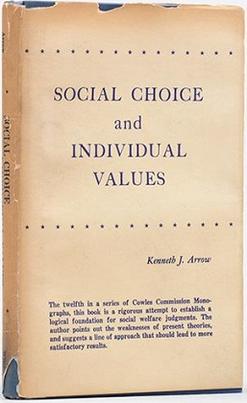The Condorcet paradox in social choice theory is a situation noted by the Marquis de Condorcet in the late 18th century, in which collective preferences can be cyclic, even if the preferences of individual voters are not cyclic. This is paradoxical, because it means that majority wishes can be in conflict with each other: Suppose majorities prefer, for example, candidate A over B, B over C, and yet C over A. When this occurs, it is because the conflicting majorities are each made up of different groups of individuals.
Pareto efficiency or Pareto optimality is a situation where no action or allocation is available that makes one individual better off without making another worse off. The concept is named after Vilfredo Pareto (1848–1923), Italian civil engineer and economist, who used the concept in his studies of economic efficiency and income distribution. The following three concepts are closely related:
As a topic of economics, utility is used to model worth or value. Its usage has evolved significantly over time. The term was introduced initially as a measure of pleasure or happiness as part of the theory of utilitarianism by moral philosophers such as Jeremy Bentham and John Stuart Mill. The term has been adapted and reapplied within neoclassical economics, which dominates modern economic theory, as a utility function that represents a consumer's ordinal preferences over a choice set, but is not necessarily comparable across consumers or possessing a cardinal interpretation. This concept of utility is personal and based on choice rather than on pleasure received, and so requires fewer behavioral assumptions than the original concept.
Arrow's impossibility theorem, the general possibility theorem or Arrow's paradox is an impossibility theorem in social choice theory that states that when voters have three or more distinct alternatives (options), no ranked voting electoral system can convert the ranked preferences of individuals into a community-wide ranking while also meeting the specified set of criteria: unrestricted domain, non-dictatorship, Pareto efficiency, and independence of irrelevant alternatives. The theorem is often cited in discussions of voting theory as it is further interpreted by the Gibbard–Satterthwaite theorem. The theorem is named after economist and Nobel laureate Kenneth Arrow, who demonstrated the theorem in his doctoral thesis and popularized it in his 1951 book Social Choice and Individual Values. The original paper was titled "A Difficulty in the Concept of Social Welfare".
In welfare economics, a social welfare function is a function that ranks social states as less desirable, more desirable, or indifferent for every possible pair of social states. Inputs of the function include any variables considered to affect the economic welfare of a society. In using welfare measures of persons in the society as inputs, the social welfare function is individualistic in form. One use of a social welfare function is to represent prospective patterns of collective choice as to alternative social states. The social welfare function provides the government with a simple guideline for achieving the optimal distribution of income.
The independence of irrelevant alternatives (IIA), also known as binary independence or the independence axiom, is an axiom of decision theory and various social sciences. The term is used in different connotation in several contexts. Although it always attempts to provide an account of rational individual behavior or aggregation of individual preferences, the exact formulation differs widely in both language and exact content.
Welfare economics is a field of economics that applies microeconomic techniques to evaluate the overall well-being (welfare) of a society. This evaluation is typically done at the economy-wide level, and attempts to assess the distribution of resources and opportunities among members of society.
Social choice theory or social choice is a theoretical framework for analysis of combining individual opinions, preferences, interests, or welfares to reach a collective decision or social welfare in some sense. Whereas choice theory is concerned with individuals making choices based on their preferences, social choice theory is concerned with how to translate the preferences of individuals into the preferences of a group. A non-theoretical example of a collective decision is enacting a law or set of laws under a constitution. Another example is voting, where individual preferences over candidates are collected to elect a person that best represents the group's preferences.

Kenneth Arrow's monograph Social Choice and Individual Values and a theorem within it created modern social choice theory, a rigorous melding of social ethics and voting theory with an economic flavor. Somewhat formally, the "social choice" in the title refers to Arrow's representation of how social values from the set of individual orderings would be implemented under the constitution. Less formally, each social choice corresponds to the feasible set of laws passed by a "vote" under the constitution even if not every individual voted in favor of all the laws.
The revelation principle is a fundamental principle in mechanism design. It states that if a social choice function can be implemented by an arbitrary mechanism, then the same function can be implemented by an incentive-compatible-direct-mechanism with the same equilibrium outcome (payoffs).
In game theory, the traveler's dilemma is a non-zero-sum game in which each player proposes a payoff. The lower of the two proposals wins; the lowball player receives the lowball payoff plus a small bonus, and the highball player receives the same lowball payoff, minus a small penalty. Surprisingly, the Nash equilibrium is for both players to aggressively lowball. The traveler's dilemma is notable in that naive play appears to outperform the Nash equilibrium; this apparent paradox also appears in the centipede game and the finitely-iterated prisoner's dilemma.
In social choice theory, a dictatorship mechanism is a rule by which, among all possible alternatives, the results of voting mirror a single pre-determined person's preferences, without consideration of the other voters. Dictatorship by itself is not considered a good mechanism in practice, but it is theoretically important: by Arrow's impossibility theorem, when there are at least three alternatives, dictatorship is the only ranked voting electoral system that satisfies unrestricted domain, Pareto efficiency, and independence of irrelevant alternatives. Similarly, by Gibbard's theorem, when there are at least three alternatives, dictatorship is the only strategyproof rule.
Single-peaked preferences are a class of preference relations. A group of agents is said to have single-peaked preferences over a set of possible outcomes if the outcomes can be ordered along a line such that:
- Each agent has a "best outcome" in the set, and -
- For each agent, outcomes that are further from his or her best outcome are preferred less.
In economics and other social sciences, preference refers to the order in which an agent ranks alternatives based on their relative utility. The process results in an "optimal choice". Preferences are evaluations and concern matter of value, typically in relation to practical reasoning. An individual's preferences are determined purely by a person's tastes as opposed to the good's prices, personal income, and the availability of goods. However, people are still expected to act in their best (rational) interest. In this context, rationality would dictate that an individual will select the option that maximizes self-interest when given a choice. Moreover, in every set of alternatives, preferences arise.
In cooperative game theory and social choice theory, the Nakamura number measures the degree of rationality of preference aggregation rules, such as voting rules. It is an indicator of the extent to which an aggregation rule can yield well-defined choices.
Maximal lotteries refers to a probabilistic voting system first considered by the French mathematician and social scientist Germain Kreweras in 1965. The method uses preferential ballots and returns so-called maximal lotteries, i.e., probability distributions over the alternatives that are weakly preferred to any other probability distribution. Maximal lotteries satisfy the Condorcet criterion, the Smith criterion, reversal symmetry, polynomial runtime, and probabilistic versions of reinforcement, participation, and independence of clones.
In cooperative game theory, a hedonic game is a game that models the formation of coalitions (groups) of players when players have preferences over which group they belong to. A hedonic game is specified by giving a finite set of players, and, for each player, a preference ranking over all coalitions (subsets) of players that the player belongs to. The outcome of a hedonic game consists of a partition of the players into disjoint coalitions, that is, each player is assigned a unique group. Such partitions are often referred to as coalition structures.
Random priority (RP), also called Random serial dictatorship (RSD), is a procedure for fair random assignment - dividing indivisible items fairly among people.
In social choice and operations research, the egalitarian rule is a rule saying that, among all possible alternatives, society should pick the alternative which maximizes the minimum utility of all individuals in society. It is a formal mathematical representation of the egalitarian philosophy. It also corresponds to John Rawls' principle of maximizing the welfare of the worst-off individual.
Fractional social choice is a branch of social choice theory in which the collective decision is not a single alternative, but rather a weighted sum of two or more alternatives. For example, if society has to choose between three candidates: A B or C, then in standard social choice, exactly one of these candidates is chosen, while in fractional social choice, it is possible to choose "2/3 of A and 1/3 of B". A common interpretation of the weighted sum is as a lottery, in which candidate A is chosen with probability 2/3 and candidate B is chosen with probability 1/3. Due to this interpretation, fractional social choice is also called random social choice, probabilistic social choice, or stochastic social choice. But it can also be interpreted as a recipe for sharing, for example:




